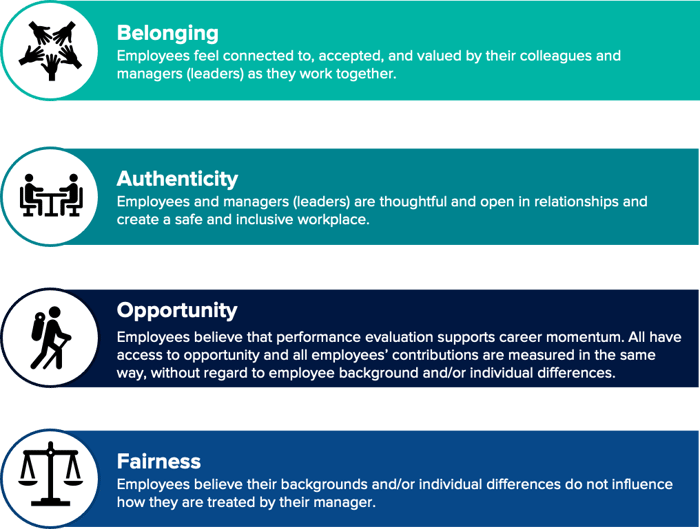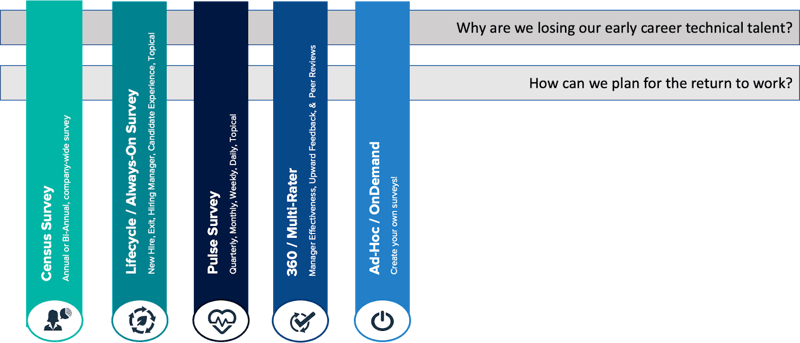The start of a new year inspires many of us to create resolutions or new approaches we will adopt in our actions or thinking. Instead of resolving to losing 20 pounds, what if we resolved to think differently about what is most important when it comes to our employees? 2020 has taught us that what we thought we knew about the employee experience didn’t apply in pandemic times. Dr. Sarah Johnson, VP of Enterprise Surveys and Analytics at Perceptyx, kicked off our first Insights & Research discussion of 2021, challenging us to apply some fresh thinking to what we measure and action in organization surveys. If employee engagement made sense in the past, what makes sense in 2021?
Keep Your “Foot-in-the-Door”
Sarah shared that now is the time to keep the “change-train moving down the tracks,” and related this to the foot-in-the-door technique - the influence tactic of starting with a little request in order to gain compliance with a much larger, related request. After a long, taxing 2020, now is not the time to slow down when it comes to change. HR and business leaders must keep their foot in the door to encourage new changes and ways of thinking in 2021 and beyond. One cannot wait for someone to ask you to do things differently; just keep the door open and drive change.
Seize the Moment
As Winston Churchill said, “Never let a good crisis go to waste.” Sarah noted that, “2020 gave us a license to throw out the playbook.” Many organizations postponed traditional listening programs, such as their annual census survey, and instead opted for short, action-based surveys. Pivoting in the moment allowed these organizations to respond directly to the challenges at hand, from corporate responses to COVID-19 and managing a remote workforce, to social injustice and perceptions of diversity, equity, and inclusion (DE&I). More than 100 enterprises, launching more than 300 listening programs, resulted in a client research database of over 750 million data points for analysis and insights. Perceptyx, for example, identified four pillars critical to measuring and driving DE&I in the workplace, as depicted below. Each pillar encompasses a different aspect of the employee experience linked to supporting stronger levels of DE&I.
Figure 1. Four Data-Driven Pillars Supporting DE&I
Lessons Learned in 2020 to Carry Forward in 2021
Engagement is always at the top of the list of priorities for C-Suite and HR executives. Decades of research has shown us that engagement is a necessary, but not sufficient condition for sustained organizational success. The best leaders know that they also need to create an employee experience that enables communications, builds teamwork and connections, supports productivity, and lifts morale and loyalty. There has never been a better time to listen to employees. Recent, real-time feedback from employees has helped leaders focus on what is needed now to help the organization move forward successfully.
Sarah noted that, “what we have always done, just doesn’t make sense anymore.” We will eventually come out of the COVID-19 pandemic as we did from previous global/national events and recessions. But the world will keep changing - it’s not if we’ll see another disrupting event, but rather when. Similarly, our companies will keep changing as well, with the emergence of new competitors and technologies, along with mergers and acquisitions. Sarah reminds us to carry forward these learnings into 2021 and beyond:
- Be fast. Fast, fast, fast. Given the pace of change, we had to act fast. Long periods of stasis are far from the norm, and organizations must quickly adapt to each new challenge faced.
- Good enough is good enough. Don’t let perfection get in the way of progress. Get in the field and collect the necessary data you need to make good decisions now, rather than the “perfect” decision months from now.
- Ask the questions that drive action. Questions should be actionable. Instead of focusing on drivers of engagement, maybe we should focus on understanding the elements of the employee experience that drive these other outcomes which are critical to our companies’ success. For example, asking new hires to respond to “my first work assignments made a meaningful contribution to the business” provides far more actionable insights than a typical engagement question, “I am proud to work here.”
- Take visible action. Immediately following up survey collection with visible action creates a positive feedback loop and demonstrates that participating in employee surveys drives desirable changes. This also leads to higher participation rates over time.
- Focus on issues that are meaningful in the current environment. It’s more important to solve today’s pressing problems than try to solve for and project what tomorrow’s problems may or may not be.
Moving from Engagement (noun) to Engage (verb)
Sarah challenges each of us in 2021 to move your thinking of engagement - the noun - to engage - the verb. Many organization surveys start with employee engagement as the focus, whereas others focus on the employee experience. What if we thought more broadly? That is, engagement is measured, but it is neither the sole, nor primary, focus. Similarly, employee experience is important, but not as an end in itself. Instead, our objective is to create a great employee experience that serves another purpose, to affect something else that is important to the business.
Many organizations have built a comprehensive listening strategy from annual census, to lifecycle and topical pulse surveys, which allows organizations to understand the experience at multiple points through an employee’s journey. One challenge, however, is that in many organizations, these have become silos, where these listening streams of data are viewed and treated as discrete and separate projects. Instead, we need to think of these streams of data as a systematic way to solve business problems. Organizations are better able to solve business problems by threading these multiple sources of data collected at various moments that matter, as depicted below.
Figure 2. Answering Business Questions Across Your Listening Strategy
Driving Meaningful Change
Shifting our thinking to the verb engage, organizations can better understand what really matters - connecting people data across a spectrum of survey methodologies with business outcomes to find solutions to current challenges. Sarah shared two case studies of Perceptyx clients, Cemex, and Charter Communications, who both linked employee experience to customer experience to understand where to focus efforts to improve key customer metrics. In both of these case studies, engagement was measured, but it was not the primary focus: employee experience was important as a driver of customer experience. The survey design instead spoke to the strategy and philosophy of each organization. The focus was to solve problems and make employees, and consequently the organization, more successful.
New Year. New Thinking. Clean Sheet of Paper.
After reflecting on these insights, and spring-boarding into 2021, Sarah suggests, “start with a clean sheet of paper.” Start with your organizational and HR strategy, and begin answering the following questions:
- What problems need solving?
- What needs to happen to achieve organizational success?
- What do leaders need to know or understand?
- What do we do now?
Answering questions like these will help you see the way forward, moving towards the verb, engage.
![Insights Discussion: New Year. New Thinking. [RECAP]](https://blog.perceptyx.com/hs-fs/hubfs/New-Year%2c-New-Thinking6.jpg?width=480&height=210&name=New-Year%2c-New-Thinking6.jpg)